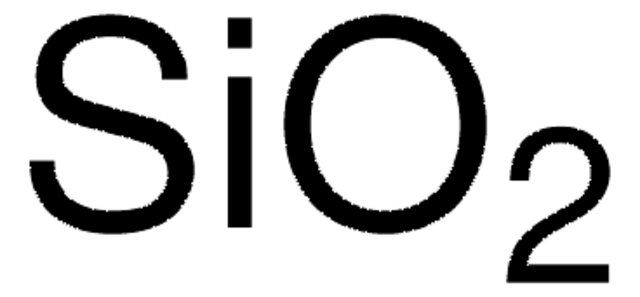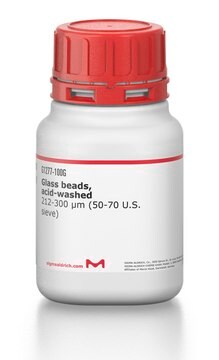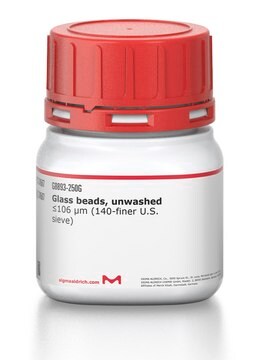All Photos(1)
About This Item
Empirical Formula (Hill Notation):
O2Si
CAS Number:
Molecular Weight:
60.08
EC Number:
MDL number:
UNSPSC Code:
23201100
PubChem Substance ID:
NACRES:
SB.52
Recommended Products
grade
high-purity grade
Quality Level
form
powder
technique(s)
LPLC: suitable
surface area
125 m2/g
matrix
Silica
matrix active group
silica
mean particle size
9-13 μm
density
1.1 g/mL at 25 °C (lit.)
suitability
suitable for acidity or alkalinity (alkalinity < 0.5 meq/g ASTM D 3100)
SMILES string
O=[Si]=O
InChI
1S/O2Si/c1-3-2
InChI key
VYPSYNLAJGMNEJ-UHFFFAOYSA-N
Looking for similar products? Visit Product Comparison Guide
General description
Silica is a naturally occurring material in minerals, flint and in some plants in crystalline phase. Silica used in industries is in synthetic form. Surface area, pore volume, pore size and particle size are independently controllable to some extent. The crystalline silica may be classified based on atmospheric pressure as:
a. Quartz = 1143K
b. Tridymite 1143 - 1743K
c. Cristobalite = 1743, over 1973K it forms amorphous vitreous silica glass.
a. Quartz = 1143K
b. Tridymite 1143 - 1743K
c. Cristobalite = 1743, over 1973K it forms amorphous vitreous silica glass.
Application
Low density filler for coatings and plastics.
Silica glass spheres are low density filler for coatings and plastics. Silica was used in synthesis of silicalite. Silica was also used to assist the catalytic growth of oxide and nitride nanowires.
Features and Benefits
Light weight, crush-resistant filler. Imparts dimensional stability, reduces warpage, reduces plastic melt viscosity and provides multidirectional orientation in reinforced composites.
Physical form
Hollow, spherical non-porous glass beads.
Storage Class Code
11 - Combustible Solids
WGK
WGK 1
Flash Point(F)
Not applicable
Flash Point(C)
Not applicable
Personal Protective Equipment
dust mask type N95 (US), Eyeshields, Gloves
Choose from one of the most recent versions:
Already Own This Product?
Find documentation for the products that you have recently purchased in the Document Library.
Customers Also Viewed
Norma A Sánchez-Flores et al.
Journal of colloid and interface science, 323(2), 359-364 (2008-05-27)
Well crystallized silicalite-1 has been obtained from three sources of amorphous silica, namely, rice hull ashes, commercial Davisil, and a fume silica from Aldrich. The silicas were first dissolved in glycerol according to a recently described reaction. This reaction transforms
The Heat Capacities of Quartz, Cristobalite and Tridymite at Low Temperatures
Anderson, C. Travis.
Journal of the American Chemical Society, 58, 568-570 (1936)
Silica-assisted catalytic growth of oxide and nitride nanowires.
Tang, C. C., et al.
Chemical Physics Letters, 333, 12-15 (2001)
Keren B Turton et al.
PloS one, 10(5), e0127243-e0127243 (2015-05-20)
Signal transducer and activator of transcription 3 (STAT3) is a key mediator of leukocyte differentiation and proliferation. The 3' end of STAT3 transcripts is subject to two alternative splicing events. One results in either full-length STAT3α or in STAT3β, which
C Uhrenfeldt et al.
Optics express, 23(11), A525-A538 (2015-06-16)
Plasmonic resonances in metal nanoparticles are considered candidates for improved thin film Si photovoltaics. In periodic arrays the influence of collective modes can enhance the resonant properties of such arrays. We have investigated the use of periodic arrays of Al
Our team of scientists has experience in all areas of research including Life Science, Material Science, Chemical Synthesis, Chromatography, Analytical and many others.
Contact Technical Service







